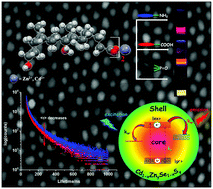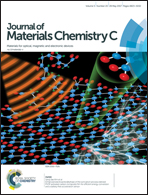Ligand mediated excited state carrier relaxation dynamics of Cd1−xZnxSe1−ySy NCs derived from bile salts†
Abstract
Bile salts of cadmium and zinc provide a convenient and inexpensive single step synthetic route for highly photoluminescent and stable semiconductor nanocrystals (NCs). The high thermal stabilities of cadmium and zinc deoxycholates (CdDCh2 and ZnDCh2) allow us to fine-tune the synthesis of the NCs at high temperatures while maintaining the monodispersity, crystallinity and reproducibility. Organic capping agent induced lattice strain affects the excited state relaxation processes of the NCs. The analysis of photoluminescence decay profiles revealed that the average lifetime decreased with the increasing lattice strain of the NCs. A kinetic stochastic model of photoexcited carrier relaxation dynamics of NCs has been employed to estimate the values of the radiative recombination rates, the photoluminescence quenching rates and the non-radiative recombination rates of the NCs. These data showed that the non-radiative relaxation rates and the number of surface trap states increase with the increasing lattice strain of the NCs. Such types of NCs can have great potential in nonlinear optical properties, photocatalysis and solar cells.



 Please wait while we load your content...
Please wait while we load your content...